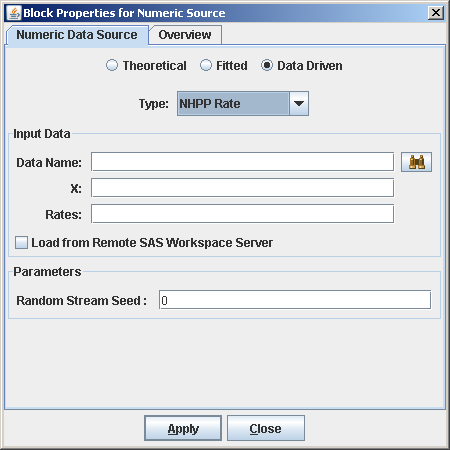For the NHPP Rate option under the Data Driven option of a Numeric Source block, the following inputs are required as shown in Figure B.5:
-
Data Name: The location of the SAS data set or JMP table that contains the data to be used to estimate a cumulative intensity (rate) function.
-
X: Name of the column in the data set that specifies the subinterval cutoff points
 so that the NHPP has an intensity function that is piecewise constant on each subinterval
so that the NHPP has an intensity function that is piecewise constant on each subinterval ![$(x_0,x_1],(x_1,x_2],...,(x_{m-1},x_ m]$](images/simsug_app20109.png) . The subintervals do not necessarily have equal widths. The NHPP is defined on the time interval
. The subintervals do not necessarily have equal widths. The NHPP is defined on the time interval ![$(0,S]$](images/simsug_app20104.png) so that
so that  ,
,  , and
, and  is the number of subintervals. The time units must be consistent with the data. For example, if the interval of interest
is from 1:00 p.m. to 5:30 p.m., then the interval
is the number of subintervals. The time units must be consistent with the data. For example, if the interval of interest
is from 1:00 p.m. to 5:30 p.m., then the interval ![$(x_0,x_ m]$](images/simsug_app20112.png) is
is ![$(0,4.5]$](images/simsug_app20113.png) if the data are in hours or
if the data are in hours or ![$(0,270]$](images/simsug_app20114.png) if the data are in minutes.
if the data are in minutes.
-
Rates: Name of the column in the data set where each value
 is the estimated rate of arrivals over each subinterval. Specifically,
is the estimated rate of arrivals over each subinterval. Specifically,  is the rate of arrivals over the subinterval
is the rate of arrivals over the subinterval ![$(x_0,x_1]$](images/simsug_app20116.png) . The length of the Rates column should be one less than the length of the X column. Furthermore, the units of the rates
. The length of the Rates column should be one less than the length of the X column. Furthermore, the units of the rates  must be consistent with the rest of the simulation model. For example, if the units used in the model are minutes, then the
rates
must be consistent with the rest of the simulation model. For example, if the units used in the model are minutes, then the
rates  must be specfied in number of arrivals per minute.
must be specfied in number of arrivals per minute.
